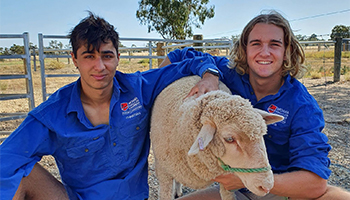Animals provide a great learning opportunity for students, and schools can ensure their care and safety are priorities.
There are many reasons why a school will keep animals on its campus. It may be cattle or poultry to support Agricultural subjects, or lizards and amphibians to enhance Science programs or as support for students with special needs.
Jennifer Woods says while animals remain in the school, they need specialised care.
“Decisions around introducing animals as part of the school need to be thoroughly considered. The purpose behind these decisions is foremost. Then, along with choosing the type and numbers of animals, aspects like available space for the particular animal, secure enclosures, biosecurity, animal safety and general care need planning and discussion.
“Importantly, there needs to be planning for ongoing financial sustainability and work health and safety considerations for staff and students working with animals,” she says.

Federal and state legislation guides schools on animal care.
The need to have animals in a school will always closely align with the curriculum outcomes specified in school-based programs.
Jennifer says the need to have animals in a school will always closely align with the curriculum outcomes specified in school-based programs.
“Some of these enterprises such as raising beef, dairy cattle, and sheep are conducted on large rural holdings, while others such as poultry for egg production or showing, are on a micro-agriculture scale undertaken by more urban schools, Jennifer says.
“The role of emerging technologies on these enterprises provides an exciting new frontier for agriculture education. Subjects such as Marine and Aquaculture Technology, and the rising number of VET agriculture courses also offer opportunities for fish, amphibians and animals on school sites.”

The role of emerging technologies provides an exciting new frontier for agriculture education.
Whenever animals are considered for inclusion in school programs, multiple federal and state legislations need to be met.
To support schools in managing compliance, and to guide the ethical use of animals in schools, the School Animal Care and Ethics Committee (SACEC) can assist.
The committee comprises representatives from Department of Education, Catholic Education and AISNSW, along with animal specialists, veterinarians, current Agriculture teachers and community members.
To support schools in managing compliance, and to guide the ethical use of animals in schools, the School Animal Care and Ethics Committee can assist.
The SACEC supports schools with advice, site visits and maintenance of the Animals in Schools website. If you have animals in your school, or are considering including them as part of your teaching and learning programs, visit the website Animals in Schools for up-to-date information.
Over many years, amphibians and reptiles provide an interesting addition to student learning in Science and Technology programs, and more recently, there has been a rise in the use of dogs as school support animals. Further information can be found here School Support Dog Guidelines.
For further information visit the Animals in Schools website, or contact Jennifer Woods [email protected].
Photo credit: With thanks to Mount Annan Christian College and Moama Anglican Grammar School.
New to AISNSW and want to receive AISNSW Education News updates? Click here to register, and select ‘AISNSW Education News’ on the Areas of Interest/Subscriptions page.